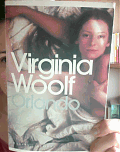
Virginia Woolf
Orlando
A Biography
It’s been awhile since I’ve had as complicated a relationship with a book as the one I’ve had with Virginia Woolf’s Orlando. The novel is denser than I first thought to look at it, but once I began to read I began to understand what I was getting myself into. Though Virginia Woolf deemed the writing of Orlando as a “writer’s holiday,” the reading of it wasn’t much of a holiday for me at all.
Many years ago I tried to read Mrs. Dalloway and made it a meager five pages through—I had better luck with Ulysses. I wonder if my problems with Orlando came from some aversion I have to Virginia Woolf’s prose, though I can’t say where the aversion lays exactly. She’s not as long-winded as John Cowper Powys, not as preachy as Lawrence, not as poetical as Annie Dillard, and her paragraphs aren’t as long as Gabriel García Márquez’s. Orlando isn’t her most lyrical (or so I’ve heard); it’s written in the style of biographical parody. There are many events that happen but not a lot going on. There is an interesting premise: Orlando begins the book as a male and halfway through transforms into a female; Orlando lives for four hundred years or so, from the 1500s to the present day (1928). There are even pictures, but yet…
Orlando was written as a mock biography based on the life of Virgina Woolf’s friend Vita Sackville-West, a woman who descended from an old English family line, who had an enormous manor, and who took women as lovers while married to a man. Orlando follows Vita’s life in a roundabout way, clasping to the implication and outline of events more than the events themselves.
Perhaps I had trouble with this book because I didn’t find Vita’s or Orlando’s life to be very interesting. Orlando grows up in England, makes friends with a queen, falls in love with a Russian princess, goes back to his big house, leaves his big house, tries to write, moves to Constantinople, and it’s a relief when he finally becomes a she. She moves back to England, tries to write, makes friends with writers, etc.
Yet the premise is interesting. When Orlando transforms from a he to a she, during a sleep of seven days, we readers are suddenly faced with another pronoun to describe the character whom we thought we knew and whom we thought gender defined. And as a result, this transformation opens up a discussion about what it was like to be a woman or a man; the disadvantages and privileges of life as one or the other (or both) during the present and the many centuries Orlando was alive for. (A Room of One’s Own, an influential feminist tract, directly followed Orlando.)
Like Orlando blurs gender, so he/she blurs through time.
An hour, once it lodges in the queer element of the human spirit, may be stretched to fifty or a hundred times its clock length; on the other hand, an hour may be accurately represented on the timepiece of the mind by one second.
And it is the combination of these two ideas that made reading Orlando worth it in the end. The time and gender shifts are close to reality despite their fantastic nature. For this reason I’m still willing to give Virginia Woolf another try, but maybe in a year or two.
· · · · · · · · · · · · · · · · · · · ·